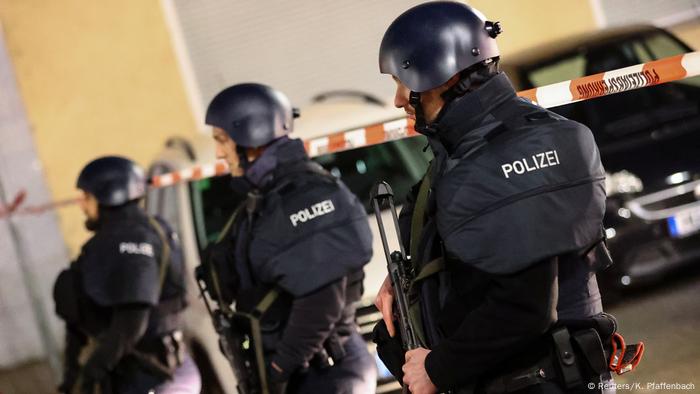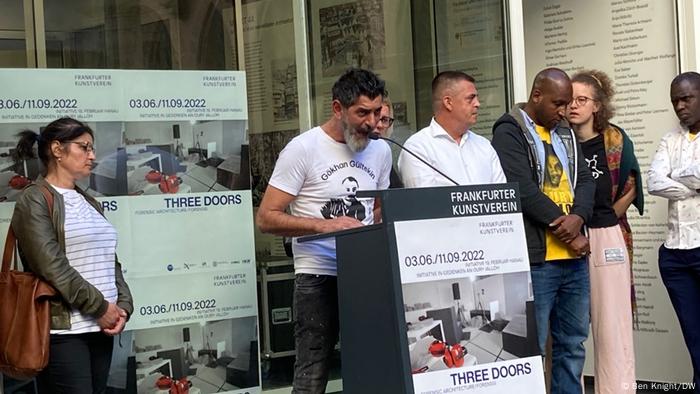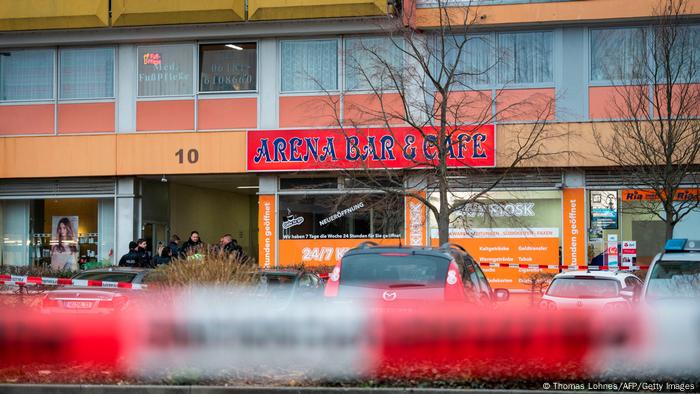German police criticized over far-right Hanau killings
Police have been accused of failing to keep tabs on a racist killer during one of Germany's worst-ever far-right shootings. Police say they had to proceed cautiously.

Relatives of the Hanau shootings question police action on the day of the attacks
An exhibition in Frankfurt about one of Germany's deadliest mass shootings has raised new questions about the police operation in the city of Hanau in the state of Hesse, on February 19, 2020. Most of the evidence on display in the exhibition has never been published before, and much had not even been made available to the state parliamentary committee investigating the security forces' role.
The 43-year-old Tobias R.*carried out a mass shooting in two bars and a kiosk, where he killed nine people of color and injured five others. He later killed his mother in their home before taking his own life. Prosecutors classified the crime as racially motivated right-wing extremism, as the gunman had posted a racist manifesto on his website.
The Hesse State Interior Minister Peter Beuth insisted that the police performed "excellent" work during the Hanau operation. But the families of the Hanau victims have repeatedly alleged that they have been subjected to policing and suspicion following the attack, while potential far-right perpetrators go unnoticed by authorities until atrocities happen.
The February 19 Initiative, which represents the Hanau survivors and victims' families, commissioned Forensic Architecture to conduct its investigation and was represented at the official opening at the Frankfurter Kunstverein on Thursday night by Cetin Gültekin, brother of Gökhan Gültekin, who was shot dead in Hanau's Arena Bar.
"We want to show the public that we are doing the work that the police should be doing," Gültekin told DW, after delivering a passionate speech to the crowd outside the gallery. "And now we put all the evidence on the table, and everything is in the open, and it shows that the police failed."

Cetin Gültekin is the brother of a victim of the hanau shooting. He says 'Our trust in the police is gone.'
Delayed action
The exhibition, by Forensic Architecture, a UK group that recently opened an office in Berlin, presented its evidence in the form of minutely detailed timelines and videos — painstakingly pieced together from witness statements, police helicopter footage, and surveillance cameras. The material was redacted to ensure it is legally publishable, though Forensic Architecture has chosen to keep its sources anonymous.
Forensic Architecture's exhibition suggests the Hesse state police failed to keep the perpetrator's house under surveillance for over an hour after they knew his address and had police cars posted nearby.
Acoustic experiments carried out by Forensic Architecture also suggest that nearby police should have been able to hear the shot when Tobias R. killed his mother.
"The fact that the police should've heard the shots, that the special units should've heard the shots — that throws up new questions," said Heike Hofmann, Social Democrat politician and part of the Hesse state parliamentary committee investigating the Hanau killings. "Maybe if they'd stormed the house earlier the mother could have been saved. Or the perpetrator may have been arrested alive."
"Forensic Architecture's work has confirmed what one could have suspected," she added later in a statement. "The police forces at the crime scenes ... were overwhelmed by the situation."
In response to the new findings, Hesse state police said the decision not to storm the perpetrator's house was made to avoid more violence. In a statement, police said officers arrived at the house around 10:50 p.m., and at first sought to communicate with him. But following "intensive reconnaissance measures and several failed attempts to make contact" the house was entered at around 3:00 a.m.
Police said that they had to be wary of scenarios including "suicide by cop," an exchange of fire with the perpetrator, or potential explosive booby-traps in the house.
"A quick and therefore highly risky operation was, following assessment of the overall situation, not required," the police said. The statement made no mention of the time windows when the house was apparently left un-surveilled, but pointed out that a helicopter was deployed to sweep the area throughout the evening.
However, the footage from the police helicopter presented at the exhibition raises its own concerns. Recordings of the pilots show they had little contact with officers on the ground, were never told the perpetrators' address, and were left to aimlessly circle the area.

The Arena Bar was one of the crime scenes in the racist shootings
The exhibition, entitled Three Doors, also presents new evidence on other aspects of the attack, including the sensitive issue of the emergency exit at the Arena Bar, where three people were killed. Forensic Architecture's exhibition shows new evidence that the emergency exit of one bar was locked on the night of the attack, allegedly at the behest of the police, who routinely raided it to look for illegal drugs.
In August 2021, Hanau state prosecutors dropped their investigation into the bar owner as they could not conclusively establish whether the emergency exit was locked on the night of the attack, or whether victims could have escaped through it.
The Forensic Architecture exhibition contradicts both of those conclusions. In response to a DW request for comment, Hanau state prosecutors said they had nothing to add to their investigation, which ended last August.
Racist police chats
Thursday's opening was marked by the palpable anger still felt by the victims' families. This was directed not only at the perceived failures in the police operation and the lack of clarity over the Arena Bar's emergency exit but also at the way victims' families were treated following the killings.
The families reported not being told where the bodies of their loved ones were being kept for four days after the killings, and receiving phone calls from police warning them not to carry out acts of revenge against the perpetrator's father, who is believed to share his son's far-right views. "We were left to ourselves," Gültekin told DW. "Our trust in the police is gone."
That sense of grievance was exacerbated last June when it emerged that 13 of the special unit officers on duty during the Hanau operation were suspended for taking part in a chat group that exchanged racist and far-right messages. The Hesse state government disbanded the unit.
In 2020, the last federal government introduced a total of 89 new measures to tackle far-right violence, investing a billion euros from 2021 to 2024 in civil society and political education projects.
But the problem of alleged far-right sympathies in the Hesse security forces has been the source of continual scandals. The state intelligence agency came under scrutiny in the 2006 murder of Halit Yozgat, a 21-year-old German with Turkish roots, by the neo-Nazi National Socialist Underground (NSU), when it emerged that an intelligence officer was present when the killing took place. More recently, questions have been asked about how a known neo-Nazi was not under surveillance when he murdered local governor Walter Lübckein Wolfhagen in 2019.
Following the Hanau killings, then-Hesse State Premier Volker Bouffier was quoted in the Frankfurter Rundschau newspaper suggesting that potential far-right sympathies said nothing about whether the police had done everything right during the operation. As that quote was flashed on a screen during the exhibition in Frankfurt on Thursday night, a groan of derision went around the room.
Edited by: Rina Goldenberg
* Editor's note: DW follows the German press code, which stresses the importance of protecting the privacy of suspected criminals or victims and urges us to refrain from revealing full names in such cases.
No comments:
Post a Comment